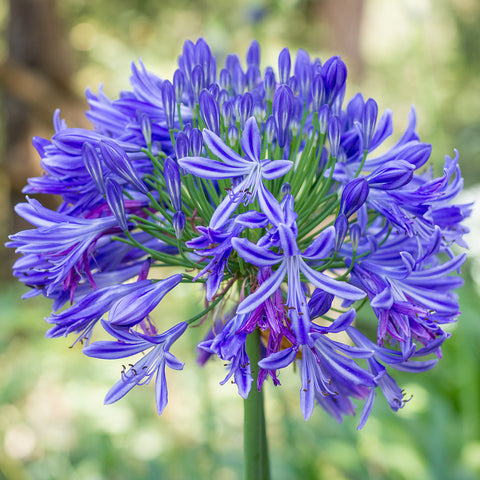Growing Agapanthus: A Total Guide to Beautiful Blooms
Growing Agapanthus: A Total Guide to Beautiful Blooms
Blog Article
Mastering the Art of Agapanthus Care: Essential Steps for Healthy Growth and Vibrant Blooms
In the realm of cultivation, the growing of agapanthus stands as a rewarding venture for those that seek to nurture these stylish blooming plants. With their striking blossoms and elegant foliage, agapanthus has caught the interest of gardeners worldwide. However, accomplishing ideal growth and lively blossoms calls for a nuanced method that includes different vital actions. From selecting the appropriate range to understanding pruning strategies, the journey towards growing thriving agapanthus plants is diverse and holds the key to unlocking the complete potential of these botanical gems.

Choosing the Right Agapanthus Variety

When choosing the appropriate Agapanthus selection for your yard, consider variables such as environment suitability, blossom shade, and growth practice. Additionally, consider the environment in your area to make certain the Agapanthus range you pick can thrive in your specific problems. Recognizing the growth routine of different Agapanthus varieties is important for correct positioning within your garden.
Ideal Planting Problems
Thinking about the ideal environmental needs is essential for effective Agapanthus farming. Agapanthus plants are sensitive to cold temperature levels and must be secured from frost during wintertime months.
To make sure healthy growth and vibrant blossoms, plant Agapanthus bulbs at a deepness of concerning 2-4 inches and room them 8-12 inches apart. Adding organic matter, such as garden compost, to the soil can enhance drain and fertility, promoting durable origin advancement. Mulching around the base of the plants aids maintain moisture and subdues weed growth. Routine watering is essential, especially during the growing period, to maintain the dirt continually moist but not waterlogged.
Watering and Feeding Tips
Keeping correct dampness degrees and providing vital nutrients are crucial components in the treatment regimen for Agapanthus plants. When it comes to sprinkling Agapanthus, it is crucial to strike an equilibrium. These plants prefer constantly damp dirt but are susceptible to root rot if overwatered.
Fertilizing Agapanthus is essential for promoting healthy development and respected blossoms. Use a well balanced plant food, such as a 10-10-10 formula, in the very early spring as new development arises. Repeat this application every 6-8 weeks throughout the expanding period. Stay clear of excessive fertilization, as it can result in rich foliage at the cost of blossoms. Constantly comply with the supplier's directions for correct dilution and application techniques. By adhering to these watering and fertilizing pointers, you can ensure your Agapanthus plants grow and produce lively, durable blossoms.
Trimming Strategies for Agapanthus
Trimming internet Agapanthus plants at the appropriate times and with correct techniques is important for keeping their health and wellness and promoting optimal development and flowering. The ideal time to trim Agapanthus remains in late winter or very early springtime prior to new growth emerges. Beginning by getting rid of any kind of yellowing or dead leaves near the base of the plant. Cut them as close to the ground as possible without damaging the arising shoots.
Deadheading spent flowers can likewise redirect the plant's energy right into generating even more flowers rather than establishing seeds. If you desire to collect seeds for breeding, leave some flowers to dry and mature on the plant.
Keep in mind to make use of tidy, sharp tools to make exact cuts and decrease the threat of introducing diseases. Agapanthus. Normal pruning will certainly aid maintain your Agapanthus looking healthy and neat while ensuring a plentiful display of lovely flowers
Dealing With Typical Pests and Illness
After ensuring appropriate pruning strategies for Agapanthus, it is necessary to deal with common bugs and diseases that can impact the wellness and vigor of these plants. Agapanthus plants are normally hardy however can still drop target to specific problems. One common insect that influences Agapanthus is the Agapanthus gall midge. This small, orange fly lays its eggs in the vegetation, resulting in distorted development and blossom buds that fail to open up. To battle this pest, trim and destroy any type of affected plant components and consider using insecticidal soap.
Another usual concern is fungal fallen leave area, which provides as dark lesions on the leaves. To stop fungal illness, ensure great air blood circulation around the plants, stay clear of above watering, and remove any kind of contaminated fallen leaves immediately. Additionally, Agapanthus plants can struggle with origin rot if they are planted in poorly draining soil. To avoid this, plant Agapanthus in well-draining dirt and stay clear of overwatering. By being watchful and taking punctual activity against parasites and diseases, you can assist your Agapanthus plants grow and create lively blooms.

Verdict
Finally, understanding the art of agapanthus treatment includes picking the click for source best selection, providing suitable growing conditions, correct watering and fertilizing, suitable trimming techniques, and dealing with typical parasites and diseases. By complying with these necessary steps, you can guarantee healthy growth and lively blooms for your agapanthus plants. Bear in mind to regularly keep track why not check here of and keep your plants to promote their total well-being and longevity.
To make certain healthy and balanced development and lively blossoms, plant Agapanthus bulbs at a depth of concerning 2-4 inches and room them 8-12 inches apart. By adhering to these watering and fertilizing tips, you can guarantee your Agapanthus plants thrive and generate vibrant, long-lasting blooms.
One common pest that affects Agapanthus is the Agapanthus gall midget. Furthermore, Agapanthus plants can endure from origin rot if they are planted in inadequately draining soil. By following these essential steps, you can make certain healthy growth and lively blossoms for your agapanthus plants.
Report this page